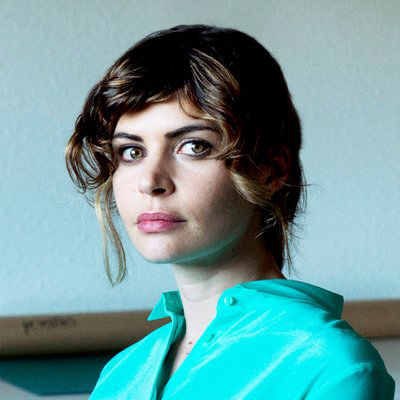Alicia Kopf
Imma Ávalos (Girona, 1982), who uses the pseudonym Alicia Kopf, has degrees in Fine Arts and in Literary Theory and Comparative Literature. In her work as a visual artist, she has had the solo exhibition Seal Sounds Under the Floor (2013) in the Galeria Joan Prats of Barcelona (GAC / DKV Prize) and has also taken part in a number of collective shows including Pis(o) pilot(o) in the Centre of Contemporary Culture of Barcelona (CCCB) in 2015, and Nonument (2014) in the Capella dels Àngels of the Barcelona Museum of Contemporary Art (MACBA). Her first novel, Germà de gel, received the Documenta Prize in 2015 and the Llibreter Prize in 2016. Imma Ávalos is a lecturer in Communications at the Open University of Catalonia and writes for different media publications. Germà de gel, published in 2016, has been translated into Spanish (Hermano de hielo), English (Brother in Ice), Portuguese (Irmão de Gelo) and Dutch (Een broer van ijs), and has received the “Ojo Crítico de Narrativa” prize in 2016, and the Cálamo Prize.
Exploring the Poles
Vicenç Pagès Jordà
Imma Ávalos Marquès (Girona, 1982), who uses pen name Alicia Kopf, has degrees in Fine Arts and Literary Theory.
The first part of her book Brother in Ice (Germà de gel) describes the deeds of polar explorers with erudition, a capacity for synthesis, and originality. In the second, longer part the story takes an autobiographical turn detailing a difficult adolescence, visits to the psychoanalyst, arguments with a dominant mother, an absent father, and the presence of her brother. The third, very brief section consists of a diary of a trip to Iceland.
In this book ice, which has also been featured in Alicia’s Kopf’s art exhibitions, unites history, the individual and geography. As a metaphor, ice represents, at the very least, intellectual exploration, sentimental coldness and emptiness. In this regard, the pieces of Brother in Ice fruitfully interact, despite the obviousness of some similes. What surprises the reader is the variety of the facets of the author who can be as playful as Vila-Matas, as melodramatic as Tennessee Williams and, like Sebald, a hunter of instants.
Catalogue of styles
The three sections comprising Brother in Ice demonstrate the author’s chameleonic skills, which could be interpreted as a catalogue of styles or a metonymic collage. She might disappear from the scene, dive into extreme egocentrism, or show interest in a landscape. In her previous book Maneres de (no) entrar a casa (Ways of (Not) Entering Your Home, 2011), she approaches a rather dramatic subject with humour. Here, she verifies heroic deeds, collects anecdotes, writes a research diary, criticises omniscient narrators, visits the contemporary art show ARCO, looks for an epic, and alternates the icy construct with naïve transcription. She is at once object and subject. Grave and light, anecdotal and transcendent, one has the sensation that Alicia Kopf isn’t sure whether she’s arrived where she wanted to go and yet she seems—rightly—satisfied with the result.Vicenç Pagès Jordà. “Explorant els pols” (“Exploring the Poles”, fragment). El Periódico (30 March 2016).
Encyclopaedia of the Cold
Julià Guillamon
In her Brother in Ice (Germà de gel) Alicia Kopf (born Imma Ávalos Marquès, in Girona, in 1982) [...] combines her experiences as a contemporary artist who has exhibited in the Galeria Joan Prats and the Fundació Antoni Tàpies, her academic training in Literary Theory and Comparative Literature, and her desire to write. On the one hand, she presents an Arctic imaginary: the cold, the great plains, the geological faults hiding beneath the white mantle. On the other hand is the epic of exploration. Kopf takes maps, photographs, stories of explorers (at times with too many passive verb forms, from Wikipedia) in order to construct a map of family, professional, sentimental and brother-related perplexity: one of the recurrent polar symbols refers to autism, which creates a barrier of ice against the world.
The reader follows the ups and downs of the story through speculative and narrative genres. Sometimes Kopf turns to the essay, a creative essay, from the artist’s book. Other times she offers an autobiographical tale: modern nightlife and ennui. There are documentary parts and strings of news items which seem to be conceptual pieces. And, at the end, as in Marina Espasa’s El dia del cérvol (The Day of the Deer), there is a journey to the far north, seeking a way out of the labyrinth. The ice melts, blocks break and when they freeze again, some are left sitting on top of others, in a new form, a fractured personality.
Brother in Ice is an unusual book, linked with an artistic project introducing the innovations which contemporary art discourse (from Fujiko Nakaya to Rori Horn) contributes to narrative. Alicia Kopf has been awarded the Documenta Prize and the Spanish edition of her book will soon appear, published by Alpha Decay. She deserves this. Let’s have a warm round of applause.
Julià Guillamon. “L’enciclopèdia del fred” (Encyclopaedia of the Cold”, fragment). La Vanguardia. Culturas (30 April 2016).




